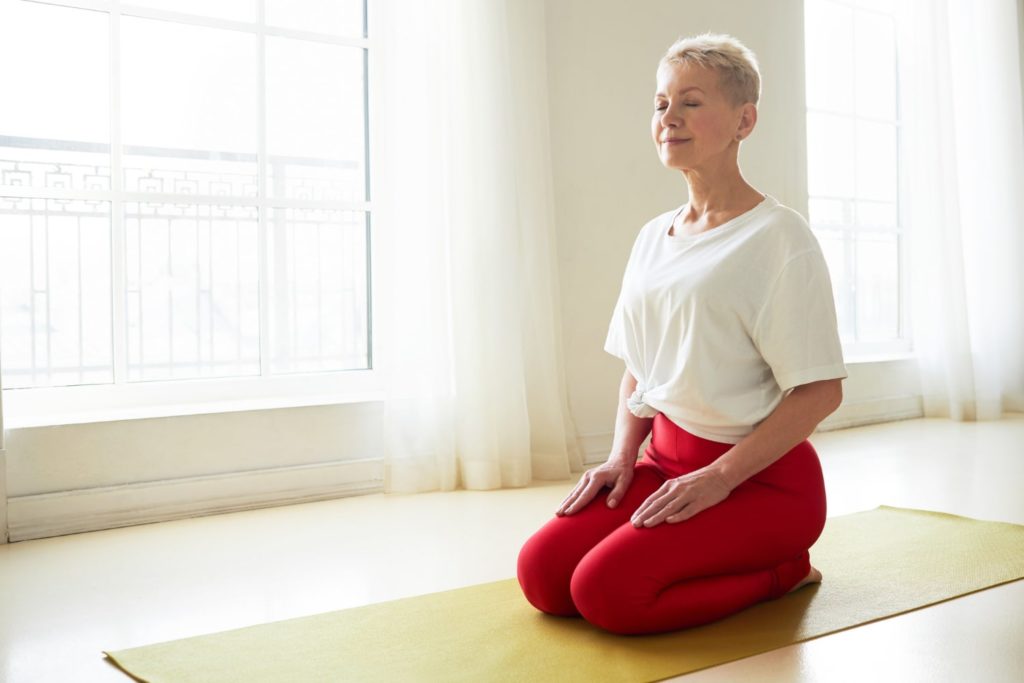
Rachael Cooper
Certified yoga instructor (Vinyasa and Hatha Yoga), CYT 200 teacher training certificate
Today, yoga is getting a lot of attention and we are seeing more studies on the impact of yoga and different health conditions. In this article, we will be focusing on how you can
- Improve mood
- Protect against the decline in grey matter cells
- Reduce the effects of anxiety and depression
- Reduce epilepsy seizures
First, let’s start with mood, because being in a good mood usually sets the tone for the rest of our day.
Mood and behaviour
Yoga’s impact on mood regulation is connected to the release of neurotransmitters such as serotonin and endorphins. These chemicals play an important role in influencing our mood.
Serotonin, often referred to as the “feel-good” neurotransmitter, is associated with promoting a positive mood and a feeling of wellbeing.[1]
Similarly, endorphins help regulate mood and also act as natural painkillers, which is vital in our overall sense of contentment.
Practising yoga helps release "feel-good" neurotransmitters
Engaging in yoga practices that stimulate the release of these mood-boosting chemicals can potentially offer a natural approach to help with regulating mood.
Regular vigorous yoga, such as vinyasa, triggers the body’s stress response, releasing endorphins. Research consistently shows this leads to a sense of achievement and boosts well-being. Regular practice improves
- immunity
- inflammation
- appetite
For maximum endorphin release, aim for three 45-minute sessions per week.[2]
One study looked at yoga’s impact on mood in 113 psychiatric inpatients at New Hampshire Hospital. To measure this study, they used the Profile of Mood States. Improvements were observed in negative emotion factors, including tension, depression, anger, fatigue, and confusion.
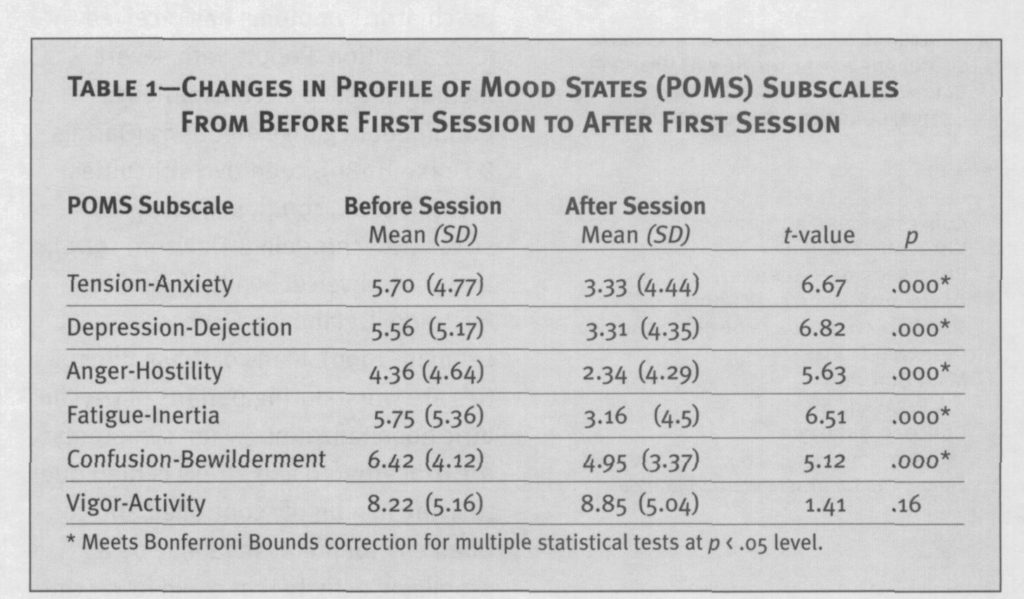
Although the study was not specifically measured for endorphins, these mood enhancements align with potential endorphin-related benefits, suggesting that yoga may serve as a stress-reducing strategy in psychiatric inpatient treatment.[3]
RELATED — Understanding Stress: The Silent Killer
Brain and grey matter
It’s only been within the last 20 years that we have seen how powerful aspects of yoga are in the protection against the decline of grey matter.
Grey matter is essential for various cognitive functions such as processing information, and memory.
MRI-based research has provided compelling insights into the effects of yoga on brain anatomy. A control group of 17 participants with an average age of 39 engaged in a mindfulness research program which involved eight weekly sessions involving formal mindfulness.
Research using MRI has shown that people who regularly practise yoga tend to have more preserved grey matter volume compared to those who don’t practise yoga.
This preservation of grey matter is particularly notable in the hippocampus region of the brain, related to attention, memory, and emotional regulation.
People who regularly practise yoga have more grey matter
Researchers found that the physical and mental aspect of yoga plays a part in boosting brain health. The combination of mindful movement, pranayama, and meditation in yoga has been shown to stimulate neural connections and promote neural plasticity. This can help with maintaining the structure and function of grey matter cells in the brain.[4]
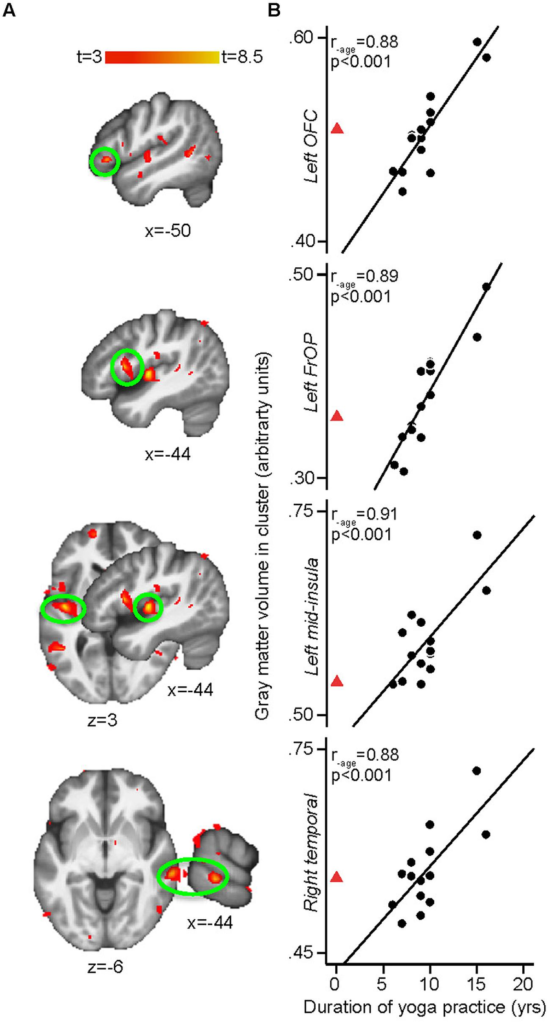
Source: Villemure, Chantal & Čeko, Marta & Cotton, Valerie & Bushnell, Mary. Neuroprotective effects of yoga practice: Age, experience and frequency -dependent plasticity. (2015)
In one particular study, 90 participants (18–50 years) over four weeks joined either a mindfulness or creative writing program. From the participants who finished the study, 50 were in the mindfulness group and 29 were placed in the creative writing group. Both groups were similar in demographics.
For the mindfulness group, increased left hippocampal volume correlated significantly with improved cognitive performance, remaining consistent in analysis.

The creative writing group did not show a significant correlation, and the impact of left hippocampus on cognitive improvement was similar between groups.[5]
Alzheimer's disease
Numerous research studies have examined the impact of yoga, notably meditation, on Alzheimer’s disease. This condition is characterised by the degeneration of nerve cells in crucial brain regions such as the neocortex and hippocampus, leading to cognitive and memory deficits.
Meditation shows the potential in enhancing brain health.
Particularly noteworthy are its positive implications for brain structure, connectivity, and cortical thickness in individuals showing mild cognitive impairment. Notably, an insightful study revealed that consistent meditation spanning only three months showed an enhancement of new motor and sensory skills.[6]
Meditation has shown encouraging results in improving attention maintenance, task-switching abilities, and focus. Such enhancements hold the potential to elevate cognitive functions, including memory and cognitive flexibility.
While short-term studies have indeed demonstrated positive brain health changes, consistent long-term practice shows stronger cognitive improvements.
The volume of the hippocampus, a brain region crucial for memory and learning, has also been implicated as potentially benefiting from meditation.
These alterations suggest an increase in neuroplasticity and neuronal connectivity which contribute to cognitive function.[6]
Anxiety and depression
Yoga’s mindfulness aspect has been shown to help alleviate symptoms of anxiety and depression and is commonly used as a tool to assist with treatment for anxiety and depression.
The connection between yoga and mental wellbeing is that it can activate the relaxation response, which is done by stimulating the vagus nerve.
The vagus nerve guides our autonomic nervous system from the stress-inducing fight-or-flight sympathetic state to the calming parasympathetic state.
The “rest-and-digest” mode (parasympathetic state) creates a sense of calmness and prevents anxiety and depression. The practice of yoga has also been tied to higher levels of GABA, a neurotransmitter that calms the brain.
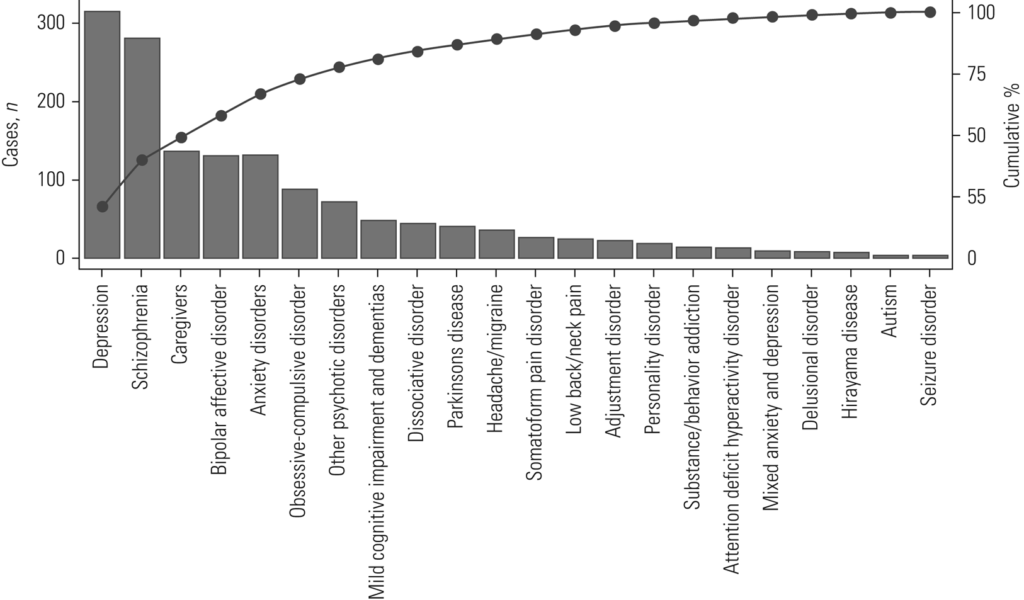
Source: Bhargav H, George S, Varambally S. Yoga and mental health: what every psychiatrist needs to know. BJPsych Advances. (2023)
An interesting 12-week study looked into the effects of yoga on anxiety and depression. The groups of people either walked or did yoga for an hour, three times a week.
The group that practised yoga displayed higher GABA levels compared to the walking group, which suggests that yoga may be more effective than walking in reducing stress levels.[7]
Yoga increases GABA levels
In a study with people experiencing depression or anxiety, they were given a choice between group Cognitive behavioural therapy or CBT combined with yoga (CBT + yoga).
RELATED — Introduction to: Depression
Those who chose CBT + yoga saw significant improvements in depressive and anxiety symptoms, outperforming those who chose only CBT.
The benefits of CBT + yoga lasted over three months, showing quicker and more lasting improvements compared to CBT alone.[8]
Epilepsy
In the last few decades studies have shown that yoga can be beneficial for those who suffer from epilepsy.
People who make yoga a regular part of their lives have found that they have fewer seizures, and that they need smaller doses of medication to manage the side effects of their condition.
One of the key ways yoga helps to control epilepsy and seizures is by stimulating the vagus nerve. This stimulation has been shown to lead to a significant reduction in seizure frequency by approximately 28-38%.
Forty epilepsy patients (15-55 years) with an average seizure frequency of 7 per month volunteered. Divided into yoga (pranayama, postures) and exercise groups, they were assessed over 10 weeks. The average seizure frequency reduced to 5 per month. Although the study didn’t have a control group it did conclude that yoga was more effective in reducing seizures than general exercises.[9]
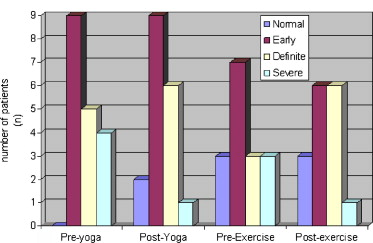
Yoga eases stress by engaging the parasympathetic nervous system, boosting GABA levels.
Its relaxation techniques stimulate EEG and the autonomic nervous system, aiding seizure control and regulating brain rhythms.[10]
Related Questions
1. What is more efficient for mental health – yoga or meditation?
We can’t exactly say whether the physical part or the meditation part of yoga is better as they both have their own benefits for mental health.
Some studies have found that meditation outperforms exercise in anxiety and also pain-related issues. However, exercise showed superiority in improving most physical health-related issues which enhance mental wellbeing.[11]
2. Can yoga help with brain wave activity?
A review of 15 studies found that yoga increases brain wave activity, suggesting that there is potential as an adjunctive treatment, especially in clinical and aging populations.[12]
3. Which parts of the brain are most affected by yoga?
Yoga has been found to primarily affect the amygdala and frontal cortex.
If you have missed the first part of the article, we suggest reading it — Psychological benefits of Yoga: what does science and research say (Part 1)
Rachael first started practicing Hatha Yoga in 2014, and since 2017 has been focused on the Iyengar method, where she learned the importance of alignment and precision in asana, and creating yoga as a discipline.
Rachael is passionate about bringing the meaning of yoga and its practice into the community to create freedom from dis-ease in the body and mind. This is why she is continuously improving and evolving as a teacher and is currently in the process of completing CYT 300 teacher training certificate.
If you would like to know more about Racheal, please visit The Yoga Project. Rachael also holds free yoga classes at the local park as well as private indoor venue sessions.
References
(1) Berry, J. (2023, March 6). What to know about endorphins. https://www.medicalnewstoday.com/articles/320839
(2) Dwivedi, M., Dubey, N., Pansari, A. J., Bapi, R. S., Das, M., Guha, M., Banerjee, R., Pramanick, G., Basu, J., & Ghosh, A. (2021a). Effects of meditation on structural changes of the brain in patients with mild cognitive impairment or Alzheimer’s Disease dementia. Frontiers in Human Neuroscience, 15. https://doi.org/10.3389/fnhum.2021.728993
(3) Lavey, R., Sherman, T., Mueser, K. T., Osborne, D. D., Currier, M., & Wolfe, R. (2005). The effects of yoga on mood in psychiatric inpatients. Psychiatric Rehabilitation Journal, 28(4), 399–402. https://doi.org/10.2975/28.2005.399.402
(4) Tang, R., Friston, K. J., & Tang, Y. (2020). Brief mindfulness meditation induces gray matter changes in a brain hub. Neural Plasticity, 2020, 1–8. https://doi.org/10.1155/2020/8830005
(5) Greenberg, J., Romero, V., Elkin-Frankston, S., Bezdek, M. A., Schumacher, E. H., & Lazar, S. W. (2018). Reduced interference in working memory following mindfulness training is associated with increases in hippocampal volume. Brain Imaging and Behavior, 13(2), 366–376. https://doi.org/10.1007/s11682-018-9858-4
(6) Dwivedi, M., Dubey, N., Pansari, A. J., Bapi, R. S., Das, M., Guha, M., Banerjee, R., Pramanick, G., Basu, J., & Ghosh, A. (2021b). Effects of meditation on structural changes of the brain in patients with mild cognitive impairment or Alzheimer’s Disease dementia. Frontiers in Human Neuroscience, 15. https://doi.org/10.3389/fnhum.2021.728993
(7) Streeter, C. C., Whitfield, T. H., Owen, L., Rein, T., Karri, S. K., Yakhkind, A., Perlmutter, R., Prescot, A. P., Renshaw, P. F., Ciraulo, D. A., & Jensen, J. E. (2010). Effects of yoga versus walking on mood, anxiety, and brain GABA levels: a randomized controlled MRS study. Journal of Alternative and Complementary Medicine, 16(11), 1145–1152. https://doi.org/10.1089/acm.2010.0007
(8) O’Shea, M., Capon, H., Skvarc, D., Evans, S., McIver, S., Harris, J., Houston, E., & Berk, M. (2022). A pragmatic preference trial of therapeutic yoga as an adjunct to group cognitive behaviour therapy versus group CBT alone for depression and anxiety. Journal of Affective Disorders, 307, 1–10. https://doi.org/10.1016/j.jad.2022.03.028
(9) Sathyaprabha, T., Satishchandra, P., Pradhan, C., Sinha, S., Kaveri, B., Thennarasu, K., Murthy, B., & Raju, T. (2008). Modulation of cardiac autonomic balance with adjuvant yoga therapy in patients with refractory epilepsy. Epilepsy & Behavior, 12(2), 245–252. https://doi.org/10.1016/j.yebeh.2007.09.006
(10) Kanhere, S., Bagadia, D. R., Phadke, V., & Mukherjee, P. S. (2018). Yoga in children with epilepsy: A randomized controlled trial. Journal of Pediatric Neurosciences, 13(4), 410. https://www.ncbi.nlm.nih.gov/pmc/articles/PMC6413605/
(11) Edwards, M. K., & Loprinzi, P. D. (2017). Comparative effects of meditation and exercise on physical and psychosocial health outcomes: a review of randomized controlled trials. Postgraduate Medicine, 130(2), 222–228. https://doi.org/10.1080/00325481.2018.1409049
(12) Desai, R., Tailor, A., & Bhatt, T. (2015). Effects of yoga on brain waves and structural activation: A review. Complementary Therapies in Clinical Practice, 21(2), 112–118. https://doi.org/10.1016/j.ctcp.2015.02.002

